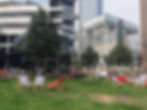Forget About Cars: Rotterdam Puts Pedestrians First
- Lior Steinberg
- Sep 16, 2019
- 4 min read
The Netherlands is a bicycle heaven, that’s common knowledge. Rotterdam is not different. True, it’s not as bicycle-friendly as Amsterdam or Groningen, but it still has bike use that almost every city in the world can be jealous at.
And that’s not all. Because unlike other Dutch cities, it is a pleasure to walk in Rotterdam. I’ve given some thought to what makes the city so walkable. Since Walk21 conference is coming to the city, I’ve decided to share my thoughts. I think that these five features are not only crucial in creating a walkable city, but they are also replicable by most cities.
Great sidewalks
In a country known for cozy, dense, and ancient city centers, Rotterdam is an anomaly. It was rebuilt after its historic center was destroyed by the Germans in 1940. Back then, the planners of Rotterdam have followed mono-functional planning paradigms: the city center is not a place to live in, but where people work and do their shopping. As a result, Rotterdam of the mid 20th century looked like many North American cities: big buildings, wide streets and plenty of room for auto vehicles.

In recent decades, the city has started to shift toward people-friendly urbanism. It included an extensive investment in bicycle facilities, reduction of roads capacity, and densification of the city center, by building taller and creating thousands of new housing units. While Rotterdam was transformed into a vibrant city, one thing stayed the same: the streets are still wide. This allows Rotterdam to provide spacious sidewalks. And specious sidewalks are great sidewalks.
Building high, keeping the ground floor interesting
Unlike most Dutch cities, Rotterdam is building high. Some of the world’s most renowned architects have designed in the city. Unfortunately, more often than not, high-rises feature boring and inactive ground floors. It is incredible to see how little some architects think about the street life around their building, forgetting their building is nothing but one piece of a big puzzle. Boring ground floors kill the public space around them, as nobody likes to walk next to dull walls.

New high-rises in Rotterdam tackle these challenges. A lot of thought is given to active ground floor spaces. This is one of the most crucial aspects of walkability in Rotterdam: passing by high-rises in the city center feels different than most places. As long as ground floors are filled with cafes, shops, and offices, you tend to forget how tall the buildings next to you are.
It is home to Europe’s first pedestrianized street
Built in the 1950s, the Lijnbaan was the first purpose-built pedestrian street in Europe. The story of the street is interesting by itself, going through a decline and rebirth in recent years (more on that by the Guardian). But I think that the Lijnbaan is more than just a pedestrianized street. The Lijnbaan is a symbol that we can still build car-free places in city centers.

For decades, we’ve been building car-dependent city centers. While many European cities have revitalized their pedestrianized streets, it is important to remember that these are all ancient, pre-war areas. The message was clear: only old places can live without the car, but no planner in their right mind would build a new city district without cars. The Lijnbaan shows it can be done differently. With all its problems and challenges, it still gives hope to the future of car-free cities.
Cycling and public transit
I cycle every day to my office, located at the heart of the city. When it’s lunchtime, I walk the Lijnbaan, grabbing something from the supermarket or a restaurant. At the end of the working day, I’d usually cycle back. But sometimes the weather is so bad that I’d ride the tram or metro to go home. Walk, bike, ride - when a city’s mobility possibilities are balanced, everybody can find their place.
That’s why it’s always important to talk about all modes of sustainable mobility when we want to promote walking. We can’t only invest in sidewalks but create an attractive package as an alternative to private vehicles. That’s where Rotterdam excels.
Keeps improving
That’s probably the thing I like the most about Rotterdam. True, it’s not as popular as Amsterdam, nor it has solved all its urban issues. Rotterdam still has challenges in inclusivity, divisions between parts of the city, and some car-dominated areas. But the city keeps trying to improve, and that’s something noble in a world addicted to the status quo.

Rotterdam was home to the Dutch first Open Streets and keeps experimenting in better public space through the Happy Streets program, which Humankind is happy to work on. It invests in green walking routes, reduction of car traffic, and improvement of public space that will attract more pedestrians. Rotterdam of today is very different than the one of a decade ago and will be very different in ten years’ time.
On 7 - 10 October, Rotterdam hosts the Walk21 conference, the international conference about walking and walkable cities. It’s a great chance to come to the city and experience what makes it such a walkable city. You’ll also have the opportunity to hear exciting speakers like Humankind’s Jorn Wemmenhove (inclusivity on the streets), Tim Beatley (Biophilic Cities), and Mitchell Reardon (The Happy City).